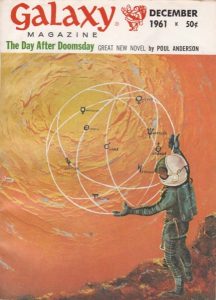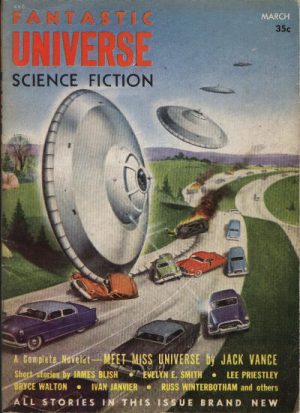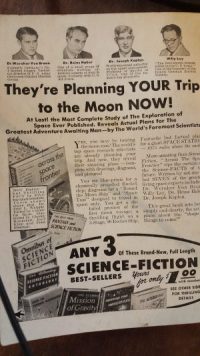Greetings all
This week I’m reading through the Galaxy, Vol. 20, No. 2, of December, 1961. It’s got a story by Poul Anderson that I’m looking forward to, and I always wonder what Willy Ley had to say. Also of note is that Frederik Pohl is the editor, and of course I always think of him as a writer. I loved the Heechee series.
As I grabbed the links for Pohl and the Heechee series, I noticed that Gateway was also originally published in Galaxy starting in November of 1976. That issue was edited by Jim Baen. Ah, the fascinating trail of science fiction publishing.

Table of Contents: http://www.isfdb.org/cgi-bin/pl.cgi?58679
Anyway, the initial editorial is by Pohl. It’s a fun one about the size of the galaxy and the possibility of alien life. Also, he talks about some planetary conjunctions.
There are all sorts of time capsule moments when reading these books and Pohl provides one. He says that Jupiter is “monarch of more than a dozen moons. (p. 7)” Right now we know of 79 moons around Jupiter. Yep, that’s definitely more than a dozen.
The issue’s first story is The Day After Doomsday by Poul Anderson. The story begins with a starship returning after a three-year mission to find the Earth destroyed. Carl Donnan is the one man who keeps his head, barely, and he tries to lead the 300 men of the ship’s crew to find those who killed his world and maybe even find some of humanity’s other spaceships. If he gets dead lucky he can find one with women on it and humanity can survive.
The story is fantastic. I’d be on pins and needles waiting for the next issue to show up in my mailbox. There are a couple of data dumps, but the rest of it is fast-paced and full of action. Aliens and politics. Ship battles. A mystery. Clues hidden here and there. And the possibility of answers more deadly than the crimes.
Fun stuff. I’m looking forward to the conclusion.
Next we have Miriam Allen deFord’s Oh, Rats. DeFord is not an author I’ve read before, though she wrote in both of my two favorite fictional areas, SF/F and mystery.
This is a twist on the Flowers for Algernon idea. SK540 is a super-rat engineered in a lab. Unfortunately, the engineering was too successful. He understands what is going on, leads an escape from the lab of his choice of the other rats, and then takes them to the house of one of the scientists.
Then he leads a fairly diabolical campaign against the scientist and his wife. He tricks them into befriending him and keeping him secret for the moment. Then he reveals that he has impregnated two other lab rats and the scientist realizes that it’s a war.
But he realizes it too late. SK540 has used rat poison (nice irony from deFord there) to kill the scientist and his wife. The story ends with the note that it’s the tale of the founder of their race and the end of humans.
This is a great story in many ways. I love the twist at the end. Yet, I’ve sat here for a bit to figure out why I detest it and I think I have the answer. SK540 wins because the wife recognizes him as a person and treats him nicely. I don’t like characters that take advantage of people being nice, so I simply can’t want him to win, not that way.
However, despite my dislike of the result, I can’t help but admire the quality of the work.
We move on to Willy Ley’s monthly essay. This one focuses on Dragons and Hot Air Balloons. In it, he talks about the possibility that the Chinese candle balloons are ancient. His argument is that they are not because Western travelers would have spoken about them prior to the 18th-century. I’m not sure I buy his argument completely, but that’s mostly because I wonder what research has occurred since 1961. He talks about the possibility that dragon banners might have been early balloons, but dismisses that too. He does so based on weight/volume ratio of the long tail.
His last segment discusses some of the biggest guns in history. He details the ones we know of and if they fired. Interesting stuff.
Then we move to Joy Leache’s Satisfaction Guaranteed. I don’t know much about her. She only had three stories published and I can’t find much about her on the internet.
This is a cute little story that where an account administrator from a promotions company is sent to a small planet to figure out something it can export so it can join the Galactic Empire. They have to have something they can contribute before getting accepted.
The problem is they have no resources. They aren’t artists. Their planet isn’t terribly attractive. As a species, the Felicians are attractive. They look like leprechauns, and they could get by setting up a tourist industry to take advantage of that. However, that would be demeaning and likely to lead to their extinction.
The get the promoter drunk, and while he’s drunk his steno, the real hero of the story, manages to figure out that the Felicians are excellent cobblers. So they set up a method to sell the shoes and it seems like the problem is at an end.
However, the Felician shoes don’t wear out and they only produce one style per species. Any others would be inefficient and demeaning for the leprechauns. That means the sales dry up within a few years.
So they go back to Felix to figure out a new plan. While there, the steno breaks a tooth. The Felicians don’t have teeth, ergo no dentists, so she has to go elsewhere. When she comes back she realizes that the Felicians, with their small size and skilled, dexterous fingers, would make excellent dentists.
It’s a cute story, but limited. It’s the kind of thing that suggests a promising author-in-training. Unfortunately, the was Leache’s last published story that I know of. Too bad.
Next is Algis Budrys’s Wall of Crystal, Eye of Night. All I can say is wow! This was an amazing story about a media mogul getting to the top of the heap, so he thinks. However, his rival has gotten advanced tech from the ancient and dying Martian race to ruin him.
The tech essentially creates a sort of virtual reality, but with less on the virtual and more on the reality. It allows someone to essentially program a person’s future within broad guidelines. In this case, the mogul’s rival curses him with an adventure that will end with sorrow and pain.
Much of the story is the mogul trying to escape this doom. He kills his rival, sort of. However, the Martian tech keeps him alive as a sort of zombie to follow the mogul and push him into wilder and wilder bad decisions. To ruin his life. Very Shakespearean.
The Martian tech succeeds and the mogul dies at the end of the story. However, he leaves behind the seeds of his revenge by using the tech on the guild agent who eventually kills him. These agents are surgically altered to make incorruptible by removing their ability to feel, or taste, or enjoy much of anything. It’s sort of like a Blade Runner thing where they are changed into replicants and can’t ever go back to being human.
The mogul’s revenge is to change this one back. Suddenly, he can feel centuries of things he’s seen and done. And now he goes back to get his vengeance and the mogul’s.
Fantastic. Would make a great movie. And, as you can see from the ISFDB, it’s been republished a number of times. Find it if you can.
To fill out the final page of Wall of Crystal, there’s an ad for one of those book clubs. I could get 6 books for $2, including stuff from Asimov, Leinster, Farmer, Anderson, Aldiss, van Vogt, and a bunch of others. Here, take my money.
The next story is Rainbird by R.A. Lafferty. Lafferty’s an inventive writer, and this is a good example.
“Inventive” jumped to mind as this story is about an inventor who is greater than da Vinci. At the end of his life, he laments about all the things he meant to improve but never did. He has done amazing things, like wiring Philadelphia for electricity in 1799, but there’s some much else to do. So, he invents a time machine and goes back to himself while his younger self was hawking.
He lays out to his younger self a huge amount of information, to which that version of himself listens intently. The younger version puts away the joys of hawks and falcons, and invents at an incredible pace. Even gets us to Mars by 1830. However, when he is 85, he curses himself for being an idiot as he has never quite gotten around to corporeal immortality. He decides to go back to yet another younger version and impress upon him the importance of immortality to allow him to achieve all that he wants and needs to.
But this younger version is distracted by the hawk and the falcon and the joys of life. Now he is remembered for a number of useful things like a safer nutmeg grater and better wedge for splitting logs. And this one never figures out the time machine and never can do anything about all the things he meant to do someday.
Very good story, but with a limitation. It’s oddly structured in that it is almost pure exposition. This structure works, though, and you get caught up into it. It needs more of the main character doing, though, to become great.
Next we get to Floyd C. Gale’s review section. The most interesting review is that of The Science Fictional Sherlock Holmes. As far as I can tell, it’s the first SF version of Holmes and includes authors like Gordon R. Dickson, Poul Anderson, and H. Beam Piper.
I had never heard of this anthology before, and it’s no wonder. It’s not published anymore, and the only places I found it was ABEBooks where I could get it for $75 or $150. No Amazon or ebook.
I’m not a huge collector of things, but this may just happen anyway.
The next story is An Old Fashioned Bird Christmas by Margaret St. Clair. St. Clair is another author I haven’t been exposed to much, which is too bad. She’s an interesting person and writer.
But I don’t think this was her best story. She was Wiccan, and this story is a melange of Christian, Norse, Wiccan, Zoroastrian, Native American, and other mythologies combined with an evil time traveling company from 3000 AD fighting over when and how to use electricity.
The main character is a reverend who wants to return to simpler, more traditional Christmas’s. One way to do that is to avoid using electric lights and rely on candles, firelight, etc. His wife is beautiful, but she was a spy implanted by the electric company to get him to stop preaching against using electrical lights after dark.
If that all seems complex, it is, and the melange has too many elements. She loves Easter Eggs, and I’ll bet most of what’s in here exists because “So-and-so will love this!” I’m not unfamiliar with the vast majority of the mythology she uses, but it whizzes by so fast I can’t quite connect all the pieces together to make the story really work for me.
I’m also not entirely fond of the ending. In the end, he wins, and a great beings says, “You want an old-time Christmas, you can have it.” The last scene is the reverend, now converted to a Druid, getting ready to sacrifice a number of Christians in honor of the winter solstice. The main character, who is a good man that you root for, then becomes evil. I love endings that aren’t happy.
Had he been the Christian sacrificed and faced his ending with pride and honor, I’d have loved it. He’d have won, though he’d have died. In this case, he’s corrupted into evil through no fault of his own, only the great evil deus ex machina making him murderous. That’s too heavy-handed for me to enjoy.
Next we get to The Watery Wonders of Captain Nemo by Theodore L. Thomas. This is actually a long form review of 20,000 Leagues Under the Sea. Thomas’s main criticism is that Jules Verne’s science is awful. He didn’t look for the technology given the submarine advances that had already been made when he wrote the story in 1870. He didn’t double-check the viability of the scientific-sounding things he says in the novel. Furthermore, we may think he advanced submarine science with his ideas, but Thomas points out that what readers think is there is not, actually, there. Batteries for the Nautilus, for example.
However, Thomas loves the way Verne tells stories. He might have missed some tech that was available to him, but he captures us in such a way that even an expert glosses over things. He calls it “non-science,” though a good story.
The last story is William W. Stuart’s The Little Man Who Wasn’t Quite. I don’t know anything about Stuart and there’s not much to find about him. I will say I wish he’d written more.
This story is about a guy who pulled himself up from the gutter, but he goes back from time to time to remind himself what he once was. While there, he meets two men, one large and obvious, and the other so withdrawn as to be almost invisible.
Turns out the withdrawn man is sliding from this universe to the next. He’s not really a part of this place, and this place is not really a part of him. That means that only people who are out of touch of this place, like those on skid row, can even see him. The main character can only see him when he’s visiting skid row, but not when he’s back at his job and real life with a newspaper.
The withdrawn man leaves, saying he’s found some other friends, so he disappears. He comes back to introduce his friend and the friend is terrifying. He has a form that seems to embody a sort of Platonic Ideal of the viewer’s greatest terror. Spiders, snakes, heights, whatever.
The terrifying creature says that’s the way it always goes and the withdrawn man promises to come back with more of them. The main character and the large man hope that the withdrawn man is so connected to the large man that if he cannot connect to the large man, he can’t get back. So the main character helps the large man succeed in society and escape skid row, where the terror lies.
Great story that catches you almost immediately even though there’s not much action, just a vague hint that yanks at your curiosity for a time until you can’t get away.
This was a very good issue. The worst story might simply be the worst because of my taste, and others might find it excellent. To me, that’s a great compliment for magazine.
Next Week’s Issue: Astounding Science Fiction of March 1961.
If you have any comments or would like to request I keep my eyes open for a specific issue or month, feel free to comment here or send an email to me at: rob@robhowell.org.
If you want to see previous reviews, the Mag Review category is here: https://robhowell.org/blog/?cat=432.
Have a great day.
Rob Howell
Author of the Shijuren-series of novels
- Website: www.robhowell.org
- Patreon: https://www.patreon.com/rhodri2112
- Blog: www.robhowell.org/blog
- Shijuren Wiki: http://www.shijuren.org/World+
of+Shijuren+Home - MeWe: https://mewe.com/i/rob.howell1
- Facebook Author Page: https://www.facebook.com/robho
well.org/ - Twitter: https://twitter.com/Rhodri2112


